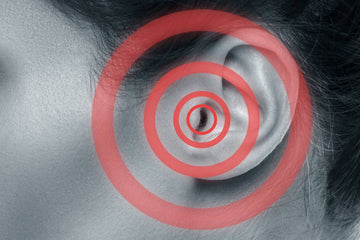Analog vs Digital Hearing Aids: What’s the Difference?
by Hear Clear on Aug 19, 2024

Navigating the world of hearing aids can be a bit like choosing between a vintage record player and a state-of-the-art sound system. Both serve the same purpose, but the experience can be vastly different. If you’re feeling a tad overwhelmed by the options, let’s shed some light on the key distinctions between analog and digital hearing aids.
What Are Analog Hearing Aids?
Analog hearing aids are the trusty veterans of the hearing aid world - they’ve been helping people hear better for decades, offering a simple and reliable solution.
How Analog Hearing Aids Work
Think of analog hearing aids like a megaphone for your ears. They take incoming sound waves, convert them into electrical signals, and then amplify those signals across all frequencies equally. It's a bit like turning up the volume on everything at once.
Features of Analog Hearing Aids
- Straightforward Amplification: They make sounds louder, which can be beneficial if you have mild to moderate hearing loss.
- No-Fuss Controls: You'll usually find a simple volume wheel for adjusting the level of amplification.
- Wallet-Friendly: Analog hearing aids tend to be more budget-conscious.
What Are Digital Hearing Aids?
Digital hearing aids, on the other hand, are the tech-savvy newcomers. They harness the power of digital processing to deliver a more personalised and nuanced hearing experience.
How Digital Hearing Aids Work
Digital hearing aids are like tiny computers for your ears. They convert sound waves into digital code, allowing for precise manipulation and customization. This means they can amplify specific frequencies, reduce background noise, and even adapt to different environments.
Features of Digital Hearing Aids
- Crystal-Clear Sound: Digital hearing aids are designed to deliver a more natural and balanced sound, making it easier to understand speech and enjoy music.
- Tailored to You: They can be fine-tuned to match your unique hearing profile, ensuring you get the most out of them.
- Focus on What Matters: Directional microphones help you zero in on sounds in front of you, like conversations at a dinner table.
- Stay Connected: Many digital hearing aids can sync with your smartphone, TV, and other devices for a seamless audio experience.
Key Differences Between Analog and Digital Hearing Aids

Let's break down the main contrasts between these two types of hearing aids:
Sound Quality and Clarity
Digital hearing aids tend to win hands down when it comes to sound quality. They can selectively amplify the frequencies you're struggling with, reducing the "muddy" or "tinny" sound that can sometimes occur with analog aids.
Customization and Adjustability
If you're looking for a hearing aid that truly adapts to your needs, digital is the way to go. An audiologist can fine-tune them with incredible precision. Analog hearing aids offer more basic adjustments.
Technology and Features
Digital hearing aids are packed with bells and whistles. Think noise reduction, directional microphones, and even Bluetooth connectivity. Analog hearing aids keep things simple.
Pros and Cons of Each Type
Both analog and digital hearing aids have their strengths and weaknesses. Let's weigh them up:
Pros of Analog Hearing Aids
- Easy to Use: If you prefer a straightforward device without a lot of fuss, an analog hearing aid might be a good fit.
- Affordable: Analog hearing aids tend to be a more economical choice.
- Reliable: They are generally sturdy and less prone to damage from moisture or dust.
Cons of Analog Hearing Aids
- Limited Flexibility: Analog hearing aids can't be customised to the same extent as digital ones.
- Struggles in Noise: They might not be the best option if you frequently find yourself in noisy environments.
- No Fancy Features: You won't get the advanced technology and connectivity options that digital hearing aids offer.
Pros of Digital Hearing Aids
- Exceptional Sound: Digital hearing aids provide a clearer, more natural listening experience, even in challenging situations.
- Feature-Rich: From noise reduction to Bluetooth streaming, digital hearing aids offer a wealth of features to enhance your hearing.
- Personalised to Perfection: Your audiologist can fine-tune them to match your unique hearing loss and lifestyle.
Cons of Digital Hearing Aids
- Higher Price Tag: Digital technology comes at a cost, so they tend to be more expensive than analog options.
- Can Be Complex: Some digital hearing aids have a steeper learning curve, especially if you're not tech-savvy.
- Battery Life: Depending on the features you use, you might need to replace the batteries more often.
How to Choose the Right Hearing Aid for You
The best hearing aid for you depends on your individual needs and preferences. Factors to consider include:
- Your Hearing Loss: The severity and type of your hearing loss will influence which type of hearing aid is most suitable.
- Your Lifestyle: Do you spend a lot of time in noisy environments? Do you want to stream music or phone calls directly to your hearing aids?
- Your Budget: Hearing aids range in price, so it's important to find one that fits your financial situation.
- Your Comfort: It's essential to choose a hearing aid that feels comfortable and fits well in your ear.
It’s also worth noting that you might find it useful to explore our guide on comparing in and behind-the-ear hearing aids as you make your decision!
The best way to make an informed decision is to consult with a qualified audiologist. They can assess your hearing, discuss your needs and lifestyle, and recommend the most appropriate hearing aids for you. Don't hesitate to ask questions and try out different models to find the perfect fit.
Final Thoughts
So, whether you opt for analog or digital, the right hearing aid can dramatically improve your quality of life. If you're ready to take the next step, why not browse our range of hearing aids online? With a bit of research and expert guidance, you can find the perfect solution to help you hear the world around you more clearly.




